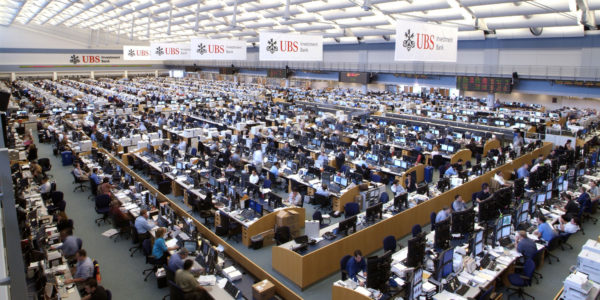
BY ELIZABETH KIM
Hearst Connecticut Media
It is a question now heard across Stamford: Will UBS stay or go?
And if the Swiss banking giant does vacate its premises on one of the city”™s prime downtown corners, how will Stamford handle the loss of one of its biggest employers and economic drivers?
Starting in the summer of 2011, there were reports that UBS, which moved its headquarters from Manhattan to Stamford in 1997, was eyeing a return to the Big Apple. Not long after, Gov. Dannel P. Malloy stepped in with a $20 million loan that is forgivable on the condition that the company keeps at least 2,000 employees in Stamford until 2017.
That is the year when UBS”™ lease on its 650,000-square-foot salmon-colored office building at 677 Washington Blvd. is set to expire.
According to recent reports, it may be difficult to justify the need for such a large space. The Wall Street Journal and the Financial News recently published stories on how changes in the financial industry, particularly in the trading business, have led to major staff cuts both at UBS and its neighbor across the street, RBS, which in May confirmed reports it would cut as many as 400 jobs over the next 18 months.
Unnamed sources in the WSJ story, which ran on July 14, said that UBS”™ trading floor, considered to be the largest in the world, is now mainly occupied by “back-office, legal and technology staffers.”
Asked to comment on the company”™s future plans, Karina Byrne, a spokeswoman for UBS, emailed the following statement: “We are not commenting or speculating, but we reiterate our commitment to keeping 2,000 jobs in the state of Connecticut as part of our five-year agreement with the state.”
According to the most recent numbers provided by the state, UBS employs 2,264 full-time employees. The staff size is almost half of what it was in 2007, when the bank had roughly 4,000 people on its payroll.
The cuts have been industrywide in Stamford. According to the Business Council of Fairfield County, as of 2005, Stamford had 13,000 people employed in finance. Today, that number has shrunk to roughly 10,700.
Joseph McGee, the vice president of public policy and programs for The Business Council of Fairfield County, said the pressure to move to Manhattan demonstrates that the financial industry as a whole is contracting and, as a result, is looking to centralize again in New York City.
McGee, who as commissioner of Connecticut”™s Department of Economic Development helped broker the deal to bring UBS to Stamford, disputed rumors that the company decided to leave Stamford because the city presented a handicap in its recruiting efforts.
“We have very sophisticated traders in hedge funds and we have no problems holding them here,” he said.
Nonetheless, he conceded, “Would traders rather be in New York? Yeah, you want to be where most of the jobs are.”
Given the upheaval in the industry, McGee said it was reasonable to believe UBS would leave Stamford after its lease runs out.
“We, as a city, need to prepare for that eventuality,” he said.
On that front, city officials acknowledge they”™ve thought about the possibility of life without UBS.
Thomas Madden, the city”™s economic development director, said city officials have ongoing conversations with all of its major employers.
“UBS and RBS play an absolute important role in our economy,” he said. “We”™d love to have them here and we are working to make sure they have a future in Stamford.”
All the same, Madden said the city is talking with state economic development officials about Stamford”™s future over the next several years. At the same time, city officials are working on a new master plan they hope will provide a road map for how the city should grow.
Another key part of Stamford”™s strategy will be to attract and foster new industries like technology and media.
“We are taking steps to ensure we have as diverse an economy as possible,” he said.
While filling any huge office vacancy in the scale of UBS will present an important test for city and state officials, most experts say that the UBS headquarters will attract significant interest, whether it be from a single corporate tenant or several willing to divide the space.
“It”™s probably one of the best, well-located facilities on the East Coast for investment banking,” said Jim Fagan, a senior managing director at Cushman & Wakefield.
Citing its modern infrastructure and proximity to transportation through the train station and I-95, Fagan described the class A office space as “everything you could want in a facility for a company of today”™s needs.”
Madden called the 15-story building “a home run for anybody to walk into right away.”
The 12-acre UBS site also presents the possibility of redevelopment, providing additional land on which a developer could to build commercial space.
Not that everyone is convinced that UBS”™ departure is a fait accompli. Jack Condlin, president and CEO of the Stamford Chamber of Commerce, said decisions of this nature are always subject to change, noting a lot depends on a company”™s management makeup at the time.
“Things can change very quickly,” he said.
Fagan agreed, saying that UBS could very well have a “change of heart” in 2017.
“This is an extraordinary opportunity,” he said of the UBS site. “It might force them to look twice.”
Hearst Connecticut Media includes four daily newspapers: Connecticut Post, Greenwich Time, The Advocate (Stamford) and The News Times (Danbury.) See stamfordadvocate.com for more from this reporter.















